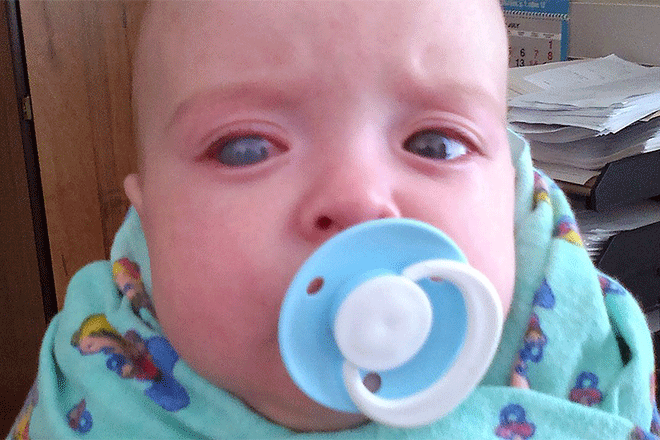Buphthalmos

What is buphthalmos?
Buphthalmos is recognized in the medical field today as an enlarged eyeball. It is usually caused by increased pressure in the developing eye for an extended period of time. The meaning of “buphthalmos” comes from the Greek word for “ox-eyed.”
It refers to a very large eyeball, and the term “ox-eyed” was used in the early period of Ancient Greece. Studies have concluded that buphthalmos is rare, occurring in an estimated 1 out of every 30,000 births.
Buphthalmos is generally identified at birth or in the infant years. It can be found in infants and small children who are born with glaucoma and who develop glaucoma within the first three years of life.
An infant’s eyes are very soft and contain a great amount of elasticity. This makes it possible for the eyeballs to become so enlarged when they are under pressure. Either one or both of the eyes can be buphthalmic. (It is usually a bilateral condition that can be asymmetric).
Causes of buphthalmos
A higher-than-normal eye pressure (IOP) is the main cause of buphthalmos. When the IOP is high, it often means that glaucoma is present. And babies with congenital glaucoma are at risk for developing buphthalmos.

A child with right eye buphthalmos, developed due to congenital glaucoma. [Image credit: "Buphthalmos" by Michalgoback is licensed under CC BY-SA 4.0 International license.]
Additionally, conditions such as the following can cause buphthalmos (or an appearance that mimics buphthalmos):
Neurofibromatosis – a condition that causes tumors to form on the nerves, brain or spinal cord.
Aniridia – partial or complete absence of the iris (colored part of the eye).
Sturge-Weber syndrome – a rare and non-hereditary neurological condition that affects the brain and eyes. A key feature of Sturge-Weber syndrome is a large port-wine birthmark located near the eye.
Each of the above conditions is often also associated with glaucoma.
Signs of buphthalmos
There are some features that are commonly found in cases of buphthalmos. Both a high IOP and large eye measurements can indicate that the condition is present.
The specific features are as follows:
Increased length of the eye (can only be measured by certain in-office examination techniques)
Increased diameter of the cornea (also measured in-office)
Buphthalmos treatment
The goal of treatment for buphthalmos is to reduce IOP in the eye(s) affected. Doing so helps protect vision from future complications, such as:
Nerve damage
Corneal opaqueness
Other issues (outlined below)
In order to control IOP, doctors look for ways to increase the flow and drainage of aqueous humor (the fluid inside the eyes). If this fluid doesn’t move and drain properly, pressure builds in the eye.
Surgery is the main treatment method for buphthalmos. Various procedures may be recommended, including:
Cyclodestructive procedures – Used to target the part of the eye that creates the internal fluid, thereby lowering pressure.
Goniotomy – A procedure in which openings are made within the internal eye at the point through which fluid drains. With increased draining comes lower pressure.
Trabeculotomy or trabeculectomy – Additional procedures that manipulate the drain inside the eye to facilitate additional outflow and lower eye pressure. One or both of these surgeries may be performed, depending on the circumstances.
Glaucoma drainage implants – Special devices implanted in the eye to increase drainage.
Medications such as topical eye drops may also be given to manage eye pressure.
Buphthalmos is considered a sign of specific eye diseases. So the treatment can also stem from which underlying condition is present.
Complications of buphthalmos
Buphthalmos is serious and needs to be treated immediately to prevent problems with vision development. If left untreated, buphthalmos can cause complications that pose a threat to eye health.
Some of these complications are:
Corneal damage
Glaucoma
Retinal detachment and other retinal complications
Vision loss (if the condition is left untreated)
In more severe cases, these problems may need to be treated with surgery. But treating buphthalmos early greatly reduces the risks and severity of these complications.
Lastly, monitoring the effects of buphthalmos and pediatric glaucoma is crucial all throughout life. Routine visits to your eye doctor can help to ensure that vision remains healthy, and to control any other problems that may develop.
READ NEXT: What is a pediatric cataract?
Buphthalmos. StatPearls. May 2022.
Sturge-Weber syndrome. Boston Children’s Hospital. Accessed November 2022.
Childhood glaucoma. Glaucoma Research Foundation. March 2022.
Primary congenital glaucoma (infantile glaucoma). EyeRounds.org. June 2005.
Cyclodestructive procedures: Types and techniques. American Academy of Ophthalmology. May 2022.
The trabecular meshwork: Structure, function and clinical implications. A review of the literature. Journal Français d’Ophtalmologie. September 2020.
What is a glaucoma drainage implant? American Academy of Ophthalmology. April 2022.
Primary congenital glaucoma. EyeWiki. American Academy of Ophthalmology. August 2022.
Page published on Wednesday, November 16, 2022
Medically reviewed on Monday, October 31, 2022






